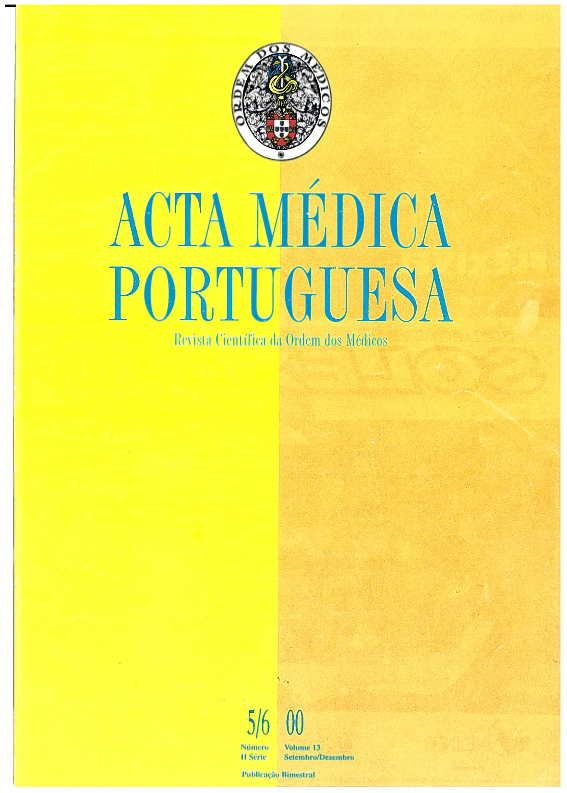Prevalence of cutaneous lesions in Freixo de Espada à Cinta.
DOI:
https://doi.org/10.20344/amp.1808Abstract
Incidence or prevalence studies on cutaneous lesions in general populations are not available. The community observed by the authors (Freixo de Espada à Cinta, North-Eastern Portugal) is relatively closed. A pre-tested questionnaire for socio-demographic and clinical information was used and a physical observation was conducted in January and February 1994 by the Dermatology Team of Santo António General Hospital, Oporto. The analysis was supported by independent tests (Pearson and Fisher chi 2, Student-t, Mann-Whitney and Kruskall-Wallis). The Spearman correlation coefficient was also used. The results indicated that 51.9% of 1000 subjects analysed were in phototype III. Concerning specific pathologies, the following percentages were observed: melanocytic nevi 81.2; hemangiomas 26.5; androgenetic alopecia 20.5; deshydrotic eczema 12.7; seborrheic keratosis 11; solar keratosis 9.6; acne vulgaris 9.5; seborrheic dermatitis 6.9; superficial mycosis 6.4; other dermatitis 5.5; vascular spiders 4.4; vulgar psoriasis 1.9; vulgar warts 1.5; pediculosis and scabiosis 1.2.; herpes simplex 0.9; impetigo 0.7; tumours (neoplasias) 0.7; dysplastic nevi 0.6; urticaria 0.3. More than nine nevi were counted in 50% of the subjects observed. A difference was observed (p < 0.05) concerning the presence of nevi, mycosis, hemangiomas, non-specific dermatitis, vascular spider and solar keratosis according to sex. The females had more nevi in number than males (Mann-Whitney, p = 0.03). According to age there was a difference concerning the presence of nevi, superficial mycosis, deshydrotic eczema, seborrheic dermatitis, acne, psoriasis, tumours, hemangiomas, non-specific dermatitis, vascular spider, solar keratosis (with linear augmentation by age) and seborrheic keratosis. Nevi increased with ageing (Rs = 0.10 p < 0.001) and a greater number were observed in age groups 0-9 and 60 or more years. Acne was observed in 9.4% of the females and 9.7% of the males, 46.2% in the 15-29 year-old age group. This study indicated that the population had a mean of nine nevi. Psoriasis was similar to that mentioned in other studies: about 1% in the United States of America. Atopic dermatitis (5.5%) is below the values for the northern population (> = 15%), but above that indicated for the English and American population. Nevertheless, the values of the present study were higher than those in the latter populations, when children until seven years old were considered. The Freixo de Espada à Cinta population above 60 years had solar keratosis in 30.6%, a value three times higher than the previous decade (10.9%); reference values were not found. Contrary to the literature, an association was not established between phototype and solar keratosis. Cutaneous tumours were observed in 0.7% of the cases.Downloads
Downloads
How to Cite
Issue
Section
License
All the articles published in the AMP are open access and comply with the requirements of funding agencies or academic institutions. The AMP is governed by the terms of the Creative Commons ‘Attribution – Non-Commercial Use - (CC-BY-NC)’ license, regarding the use by third parties.
It is the author’s responsibility to obtain approval for the reproduction of figures, tables, etc. from other publications.
Upon acceptance of an article for publication, the authors will be asked to complete the ICMJE “Copyright Liability and Copyright Sharing Statement “(http://www.actamedicaportuguesa.com/info/AMP-NormasPublicacao.pdf) and the “Declaration of Potential Conflicts of Interest” (http:// www.icmje.org/conflicts-of-interest). An e-mail will be sent to the corresponding author to acknowledge receipt of the manuscript.
After publication, the authors are authorised to make their articles available in repositories of their institutions of origin, as long as they always mention where they were published and according to the Creative Commons license.









